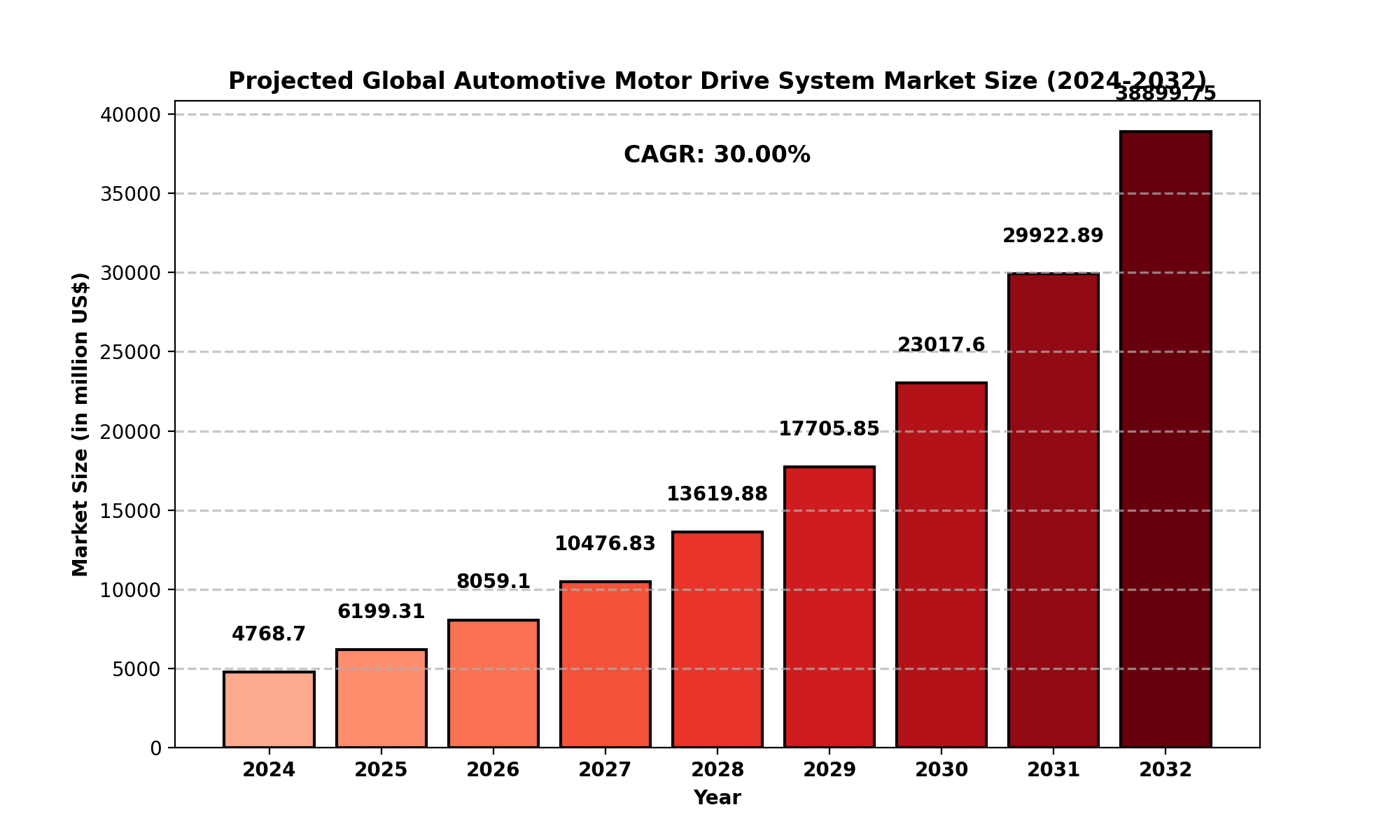TOP CATEGORY: Chemicals & Materials | Life Sciences | Banking & Finance | ICT Media

Download Report PDF Instantly
Report overview
The Automotive Motor Drive System refers to the system used for controlling the speed, torque, and direction of an electric motor in a vehicle. These systems are crucial in Electric Vehicles (EVs), hybrids, and even traditional vehicles with electric-powered components. Automotive motor drive systems include various control mechanisms, power inverters, and controllers that adjust the power supply and output based on the driving conditions, ensuring optimal performance and energy efficiency. With advancements in EV technology, the demand for efficient and reliable automotive motor drive systems is rapidly increasing.
The global Automotive Motor Drive System market size was valued at USD 4,768.70 million in 2024 and is expected to grow at a compound annual growth rate (CAGR) of 30.00%, reaching a projected value of USD 38,899.75 million by 2032.
This impressive growth trajectory reflects the increasing adoption of electric vehicles (EVs) and the push towards reducing greenhouse gas emissions, which fuels the demand for more efficient motor drive systems. The rising preference for battery electric vehicles (BEVs), along with the global shift toward sustainable automotive technologies, plays a significant role in driving market growth.
Key factors contributing to the market's expansion include advancements in motor technology, the development of smart inverters, and a surge in the production of EVs across the world. The automotive industry's increasing focus on energy efficiency and electric propulsion systems further strengthens the market's growth outlook.

Drivers:
Rise of Electric Vehicles (EVs): The growth of the global EV market is one of the primary drivers for the automotive motor drive systems market. As the demand for battery electric vehicles (BEVs) and plug-in hybrid electric vehicles (PHEVs) increases, the need for robust, reliable, and high-performance motor drive systems rises accordingly.
Technological Advancements in Motor Systems: The continuous development of high-efficiency motors and power electronics has led to improvements in motor performance, energy efficiency, and driving range. These advancements directly contribute to the adoption of motor drive systems in modern vehicles.
Government Regulations and Environmental Policies: Stringent emission standards and governmental incentives for green technologies significantly boost the demand for automotive motor drive systems. The push toward carbon-neutral vehicles and sustainability is reshaping the global automotive industry.
Improved Energy Efficiency: Automakers are focusing on energy-efficient systems to meet the growing demand for electric powertrain solutions. This trend is driving the widespread adoption of motor drive systems that optimize the vehicle's energy consumption.
Restraints:
High Initial Costs: The high cost of advanced motor systems and power electronics is a major restraint in the market, especially in emerging markets. High manufacturing costs can make EVs and hybrid vehicles expensive, affecting their affordability and widespread adoption.
Limited Charging Infrastructure: While motor drive systems are critical for the performance of EVs, the lack of sufficient charging infrastructure in many regions can hinder the market's growth. Consumers may be reluctant to purchase EVs without an adequate network of charging stations.
Supply Chain Challenges: Disruptions in the supply chain, particularly for essential components like semiconductors and rare earth materials for motors, can impede market growth. The ongoing global supply chain issues affect the timely production and availability of motor systems.
Opportunities:
Integration of Autonomous Vehicles: As the automotive industry moves toward autonomous driving technologies, motor drive systems will play a vital role in controlling the motors' functionality in self-driving cars. This provides an opportunity for market players to innovate and expand their product offerings.
Rising Popularity of Hybrid Electric Vehicles (HEVs): HEVs, which combine internal combustion engines with electric motor systems, are gaining popularity due to their fuel efficiency and lower emissions compared to conventional vehicles. This presents an opportunity for automotive motor drive systems to be integrated into a broader range of vehicle types.
Growth in Emerging Markets: Emerging economies, particularly in Asia-Pacific and South America, are showing increasing interest in EV adoption. These regions represent an untapped market for automotive motor drive systems, offering significant growth potential.
Challenges:
Technological Compatibility: Ensuring compatibility between various motor drive systems and other components of an EV, such as batteries and charging systems, can be a complex challenge for manufacturers. Any technological misalignment can result in inefficiencies or malfunctions.
Competition Among Manufacturers: As the market for automotive motor drive systems grows, competition among manufacturers intensifies. Companies must focus on reducing production costs while maintaining system efficiency to stay competitive.
The global Automotive Motor Drive System market is segmented by region, with North America, Europe, Asia-Pacific, South America, and Middle East & Africa being the primary geographical segments.
North America: North America, particularly the United States, is projected to dominate the market. With the growing adoption of EVs and the increasing focus on reducing carbon emissions, the North American automotive motor drive system market is expected to reach USD 1,963.79 million by 2024, growing at a CAGR of 25.71% from 2025 through 2032.
Europe: Europe is another prominent region in the global market. With countries like Germany, France, and Norway leading the way in EV adoption, Europe continues to see significant demand for automotive motor drive systems. Stringent emission norms and governmental incentives further promote the use of electric mobility solutions.
Asia-Pacific: The Asia-Pacific region is the largest market for automotive motor drive systems, driven by the presence of major automobile manufacturers in China, Japan, South Korea, and India. The rapid adoption of EVs and the increasing push for green energy in these countries contribute to the growth of the market.
Key Players in the Automotive Motor Drive System Market:
Tesla
BYD
VWATD
Bosch Mobility Solutions
Nidec
Shanghai XPT Technology
Hyundai Transys
CRRC Times Electric
Shanghai Edrive
Anhui JEE
Inovance
Leap Motor
HASCO
Enpower
These companies are key players in the automotive motor drive systems market, known for their innovative technologies and market leadership in electric vehicle components. Their strategies include mergers, acquisitions, and research & development efforts to enhance the capabilities of motor drive systems.
Battery EVs
Plug-in EVs
Two-in-One System
Three-in-One Systems
All-in-One Systems
Tesla
BYD
VWATD
Bosch Mobility Solutions
Nidec
Shanghai XPT Technology
Hyundai Transys
CRRC Times Electric
Shanghai Edrive
Anhui JEE
Inovance
Leap Motor
HASCO
Enpower
North America (USA, Canada, Mexico)
Europe (Germany, UK, France, Russia, Italy, Rest of Europe)
Asia-Pacific (China, Japan, South Korea, India, Southeast Asia, Rest of Asia-Pacific)
South America (Brazil, Argentina, Columbia, Rest of South America)
The Middle East and Africa (Saudi Arabia, UAE, Egypt, Nigeria, South Africa, Rest of MEA)
What is the current market size of the Automotive Motor Drive System?
Which are the key companies operating in the Automotive Motor Drive System market?
What are the key growth drivers in the Automotive Motor Drive System market?
Which regions dominate the Automotive Motor Drive System market?
What are the emerging trends in the Automotive Motor Drive System market?